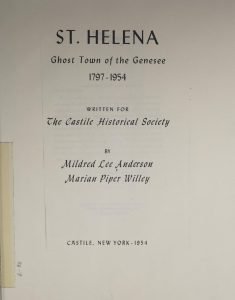St Helena, ghost town of the Genesee, 1797-1954
St. Helena is now a name only. The pioneers of the valley have moved to the shade of the maples in Castile. Not many miles from the scene of their struggles with the early wilderness and the sometimes raging Genesee, the pioneers sleep on. Will the Genesee which they loved, and sometimes feared, close at last over the tiny town site or will it be allowed to grow again to a resemblance of its former state of wilderness? Never more will the hum of mill wheels fill the valley, for St. Helena is now the “Ghost Town of the Genesee.”

